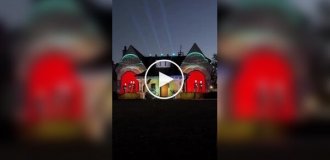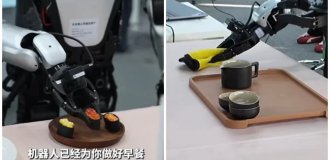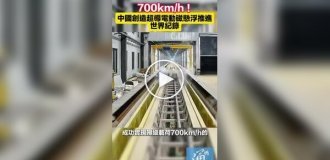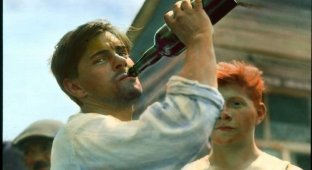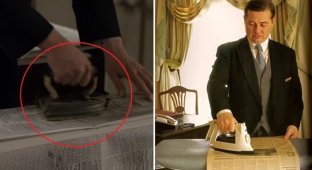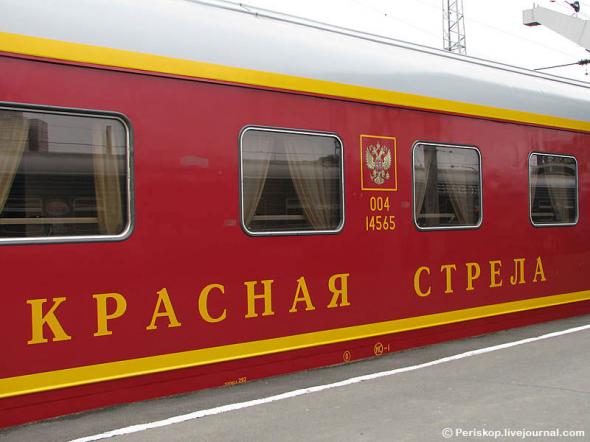
From LiveJournal Periscope.
Due to the fact that since November last year I stopped going to the ticket office, and began purchasing tickets exclusively online - through the Russian Railways website using a card, when planning trips, it became possible to comfortably choose not only a train, but also a carriage, cutting off unwanted ones. places So, on this May trip, I decided on the way back to test the “Red Arrow” (No. 1/2), especially for which an individual batch of cars was made at the Tver Carriage Plant a couple of years ago. I took II class, the equivalent of a compartment on a regular train. Most of all, I was interested in the features and style elements of this legendary train (which had existed since June 10, 1931, with a break in 1941-44). Well, for comparison, I’ll dilute my pictures a little with the old “Strela” from 1933, 1939 and 1949.
But at the beginning of his career (photo from 1933), the inscription was even bilingual, although it did not last long. And the color of the carriages was dark blue, although the name was completely different. The Red Arrow became dark red only in 1949.

By the way, at first the train departed from Moscow at 1.30 a.m. and arrived in St. Petersburg at 11.30. But in the mid-1930s, the People's Commissar of Railways of the USSR Lazar Kaganovich, by a willful decision, set the departure time at 23.55 (five minutes before midnight) - so that business travelers would receive daily allowances for two days, and not for one.
Here is the "Red Arrow" before the war at the Moscow station (presumably 1938-39). The bilingual inscription disappeared, but the inscription “Express” appeared at the bottom (it will live right up to 2007, having disappeared in the most recent reincarnation, which I was riding now).

Entrance to the carriage.

As you can see, 1 compartment has disappeared compared to a regular carriage, due to the specific layout of the carriage (more spacious vestibules, double toilets, etc.). And it turned out to be 36 - 32 places. The same thing happened with 1st class (luxury) - not 18, but 16 seats.

The compartment has soft sofas. But there is no need to make the bed at night - it is already made and is located at the back of the sofa. I opened the latch and that was it. On top you only need to take a pillow and a warm blanket. And the compartments above the back are luggage compartments for small items, there are only three of them. You can store your mobile phone, toiletries, towels, etc. I also really liked that in each compartment under the table there are two 220 V sockets. If you have a laptop, you can use it all night long. Well, or calmly charge mobile phones, PDAs, etc.

View into the compartment without flash.

And this is what a similar interior looked like in Strela 60 years ago, in 1949.

The inscription on the tablecloth.

The temperature is regulated by sensors (there are 5 fixed positions), as well as the compartment lighting.

The carriage layout is different than usual. Near the non-working vestibule there are double dry closets. And in each compartment there are occupancy indicators.

View from the compartment into the aisle, with the door open.

Here's the same thing, but with the door closed. It’s six in the morning, everyone is still sleeping, and the door is mirrored from the inside.

Individual lighting. It’s here on both sides - where it’s more convenient to lie down, towards the window or away from the window.

The carpet in the compartment is made in the "modern" style. Well, for a St. Petersburg train it’s basically logical.

View along the carriage aisle (without flash).

"Red Arrow" at the Moscow station in St. Petersburg, May 12, 2009

It's supposedly from the late 70s. It is interesting that the cars do not have the “Express” inscription (sometime in the 80s it would return, only to disappear in 2007).

And here (1949) there is an inscription. Please note that the Strela cars are already all-metal (one of the first), and the post-war platform is made of planks.

My Strela flight to St. Petersburg brought a blue ChS6, not branded.

But once upon a time, steam locomotives for the “Strela” were special, specially designed.
Here is the hard worker Su at the Moscow railway station.

He, at the entrance to the station, with the train (after the war, 1949).

But before the war, the “Red Arrow” was driven by the handsome “Joseph Stalin” in a high-speed aerodynamic casing. True, not for long, 1937 (8) - 1941. The war destroyed this tradition (almost all surviving ISs were “sick” due to wartime operation with low-quality coal), and after the war, proven, economical Su were installed on the Strela. In 1957, Strela began to be driven by high-speed diesel locomotives TE7.



